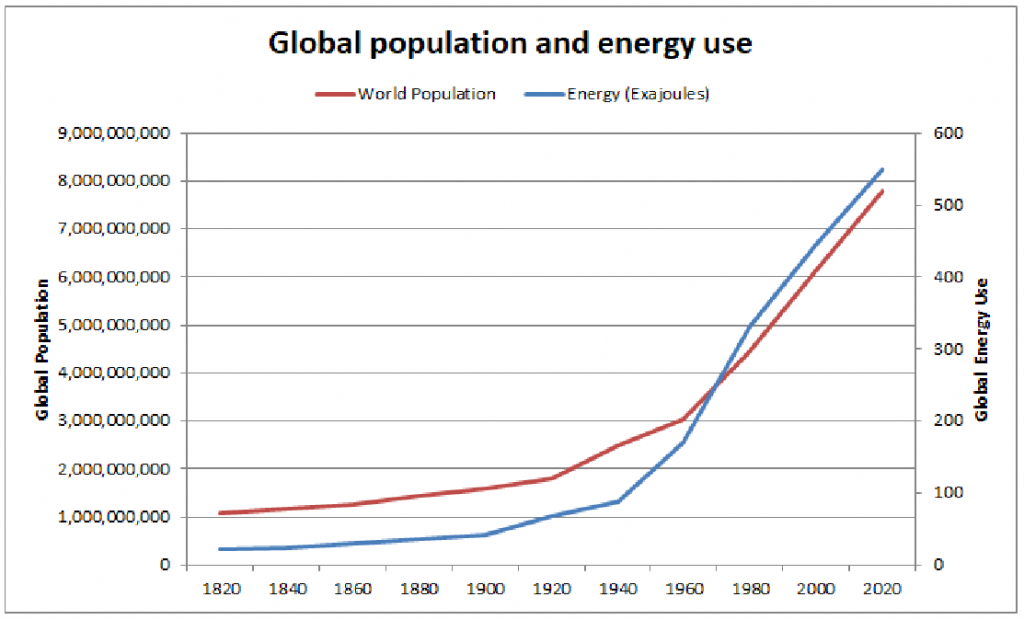While researching material for my new “paper” (or perhaps, book) on the global energy situation, I found an interesting relationship that surprises. I started my research by looking into the question of global population growth over the past 200 years. As I expected, when plotted on a graph the curve took the familiar shape of an exponential growth curve – one that is well into the “hockey stick” portion of the curve. Out of curiosity I decided to plot a curve of the global energy use over the same period of time. The results are shown on this graph:

The thing that stood out to me is the rather amazing similarities in the shape of the two curves. As I anticipated, the energy used per capita has been increasing over time as the energy use changed from mostly manual energy (which doesn’t show up on the graph) to more use of external energy sources. I was unable to determine exactly what was considered as “energy use” two hundred years ago, I assume it is referencing sources such as water power, burning of wood and coal, and possibly wind power. I don’t think it included power provided by humans or their domestic animals. In any case, those sources of power would have been minor. The important part of this to me is the observation that even throughout the introduction of the industrial age, there is a strong correlational between the growth rate of the population and that the growth rate of the use of energy – with the use of energy growing substantially faster than the overall population starting at about the time of world war II.
Finding ourselves at this point on the upward turning bend in the growth curve means that things are going to get very much worse very quickly. No matter how you look at it, we are rapidly approaching the point in time when the available resources will be used up, the point where not only can we continue to grow, but the impacts of such growth will become catastrophic in terms of lack of available resources to support the population. Unfortunately, not only will the resources be unable to sustain the vastly increase population, but even after the size of the population collapses we will be in serious trouble because the accessible resources needed to support a much smaller population will have been used up and will no longer be available
This is a similar curve that we were presented with last March with the introduction of covid-19. At that time we were on a curve roughly equivalent to 1850 on the blue curve of the graph. At that time there were a few thousand fatalities from the disease world wide. At that time, it was clear that a major pandemic was underway, even though at the time there were almost no cases in the world outside of China. We followed an exponential growth curve from the initial zero cases to over 400,000 deaths in the USA alone in a year. The curve would have been MUCH steeper had we not instituted heroic efforts to “flatten the curve.” The time line for that has the same general shape as for population and energy use, but over a different duration.
The graph of population versus energy use makes it clear that real problem is with the global rate of population growth. It is driving the use of energy, and driving it is ways that we will be unlikely to be able to maintain by just providing more energy. The only solution is to “flatten the curve” by reducing per capita consumption (or, I suppose, rapidly reduce the population). Given that we would rather avoid a rapid die-out of our population, the only solution is to find ways to get by on the energy from that can be sustained long into the future. I am convinced that this will require finding ways to reduce our use of energy while maintaining an acceptable lifestyle. It seems to me that this points to a need to achieve massive improvements in the efficiency for everything that depends upon energy use. There might still be time to “flatten the curve” of our energy demand if we really take on the problem as an existential one, which happens to be the case. Letting the curve continue steepening has only one possible outcome, which will not be a problem for “the earth” because the earth doesn’t care about anything, but it will be a huge problem for humans.